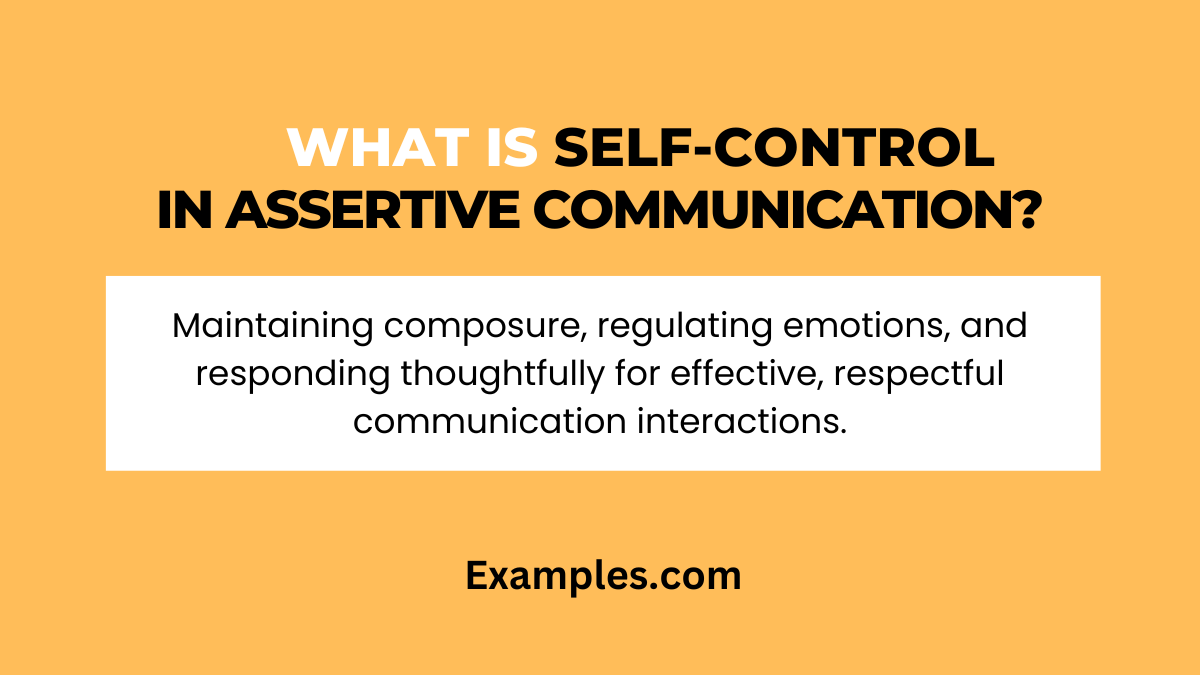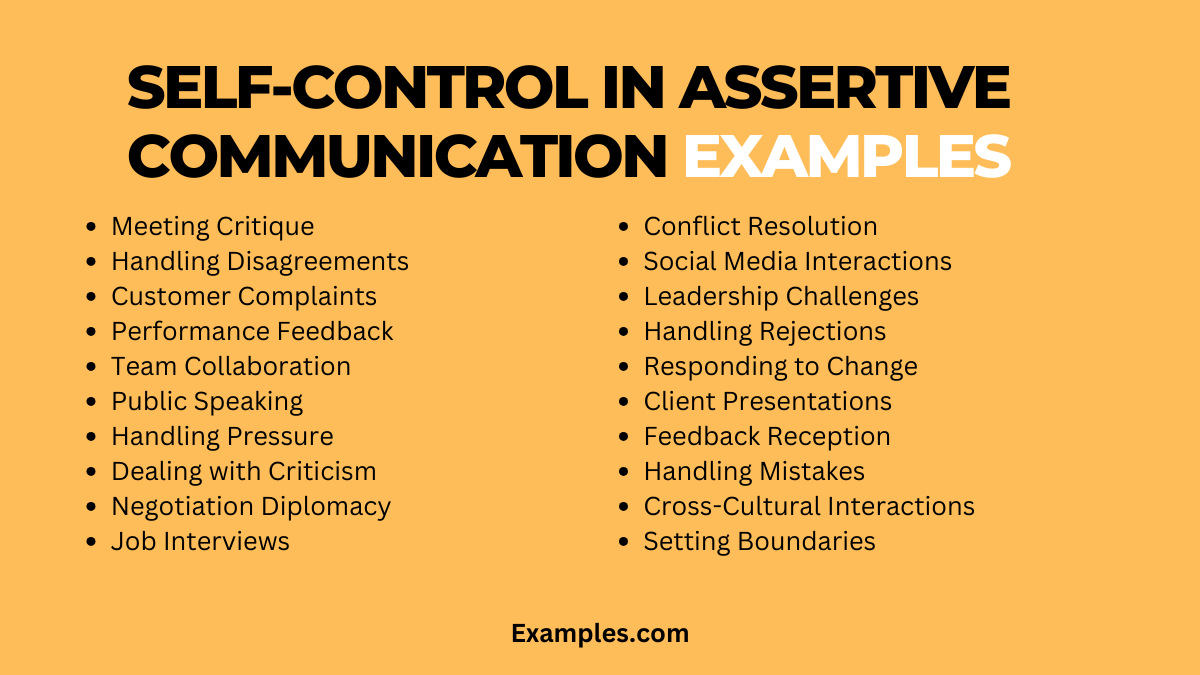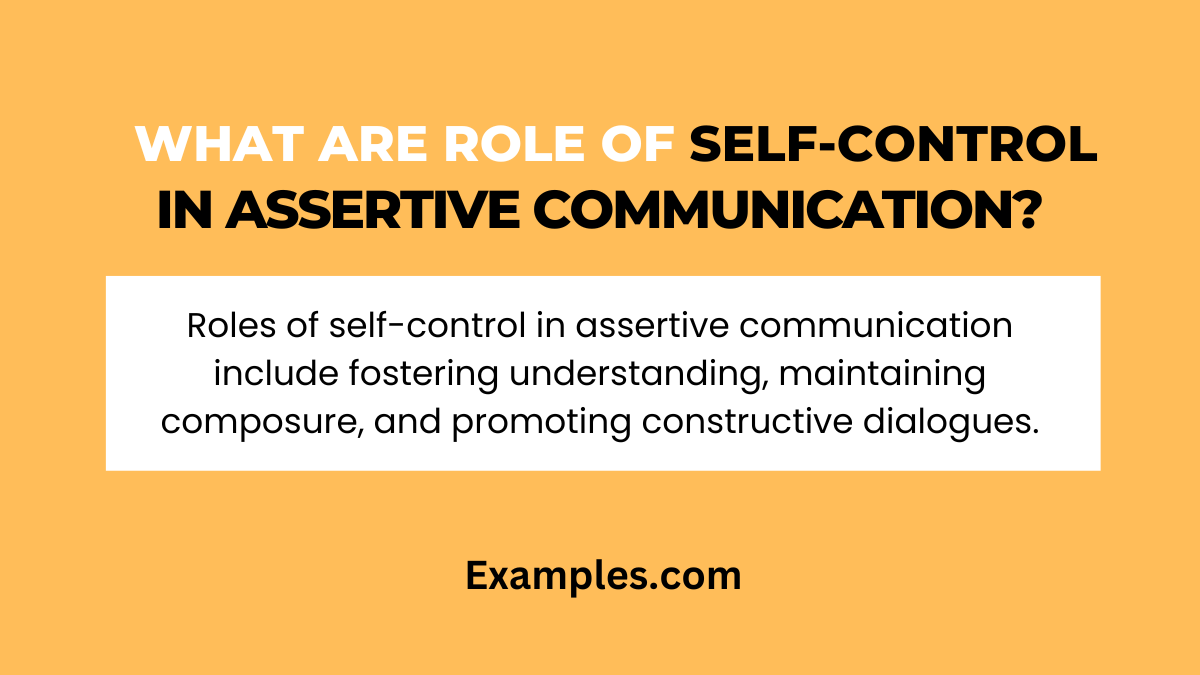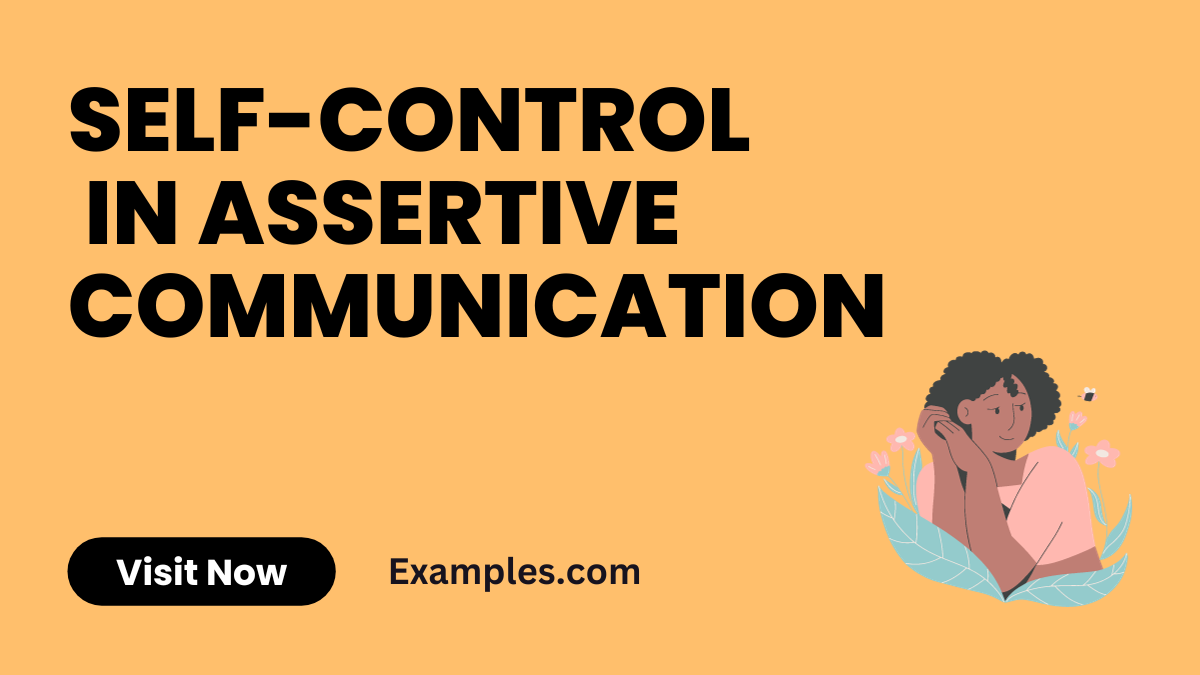19+ Self-Control in Assertive Communication Examples
Mastering self-control in assertive communication is pivotal for effective and impactful interactions. Communication examples showcase how individuals navigate conversations with composure, influencing positive outcomes.
What is Self-Control in Assertive Communication?

Self-control in assertive communication refers to the ability to manage emotions and responses, fostering a calm and composed demeanor. It empowers individuals to express thoughts confidently while respecting others’ viewpoints, creating a conducive communication environment.
Self-Control in Assertive Communication Examples

Mastering self-control in assertive communication enhances interpersonal dynamics. Employers value employees who navigate challenges with poise, showcasing emotional intelligence. These communication examples illustrate how self-control contributes to effective and respectful interactions.
- Meeting Critique Maintain self-control during critiques, responding with composed counterarguments for constructive discussions.
- Handling Disagreements In disagreements, exhibit self-control by expressing your viewpoint calmly, fostering understanding and resolution.
- Customer Complaints Respond to customer complaints with self-control, addressing issues empathetically and providing effective solutions.
- Performance Feedback Offer performance feedback with self-control, focusing on constructive aspects and guiding improvement.
- Team Collaboration In team collaborations, exercise self-control, valuing diverse opinions for innovative solutions and a harmonious work environment.
- Public Speaking Maintain self-control when speaking publicly, ensuring a composed delivery that captivates and convinces your audience.
- Handling Pressure In high-pressure situations, demonstrate self-control, making decisions thoughtfully and effectively under stress.
- Dealing with Criticism Respond to criticism with self-control, acknowledging valid points and addressing concerns diplomatically.
- Negotiation Diplomacy Exhibit self-control in negotiations, fostering compromise for mutually beneficial agreements and relationships.
- Job Interviews During job interviews, showcase self-control by answering questions confidently and maintaining a composed demeanor.
- Conflict Resolution Navigate conflicts with self-control, promoting open communication and understanding to reach amicable resolutions.
- Social Media Interactions Exercise self-control in online interactions, responding to comments or messages with respect and a measured tone.
- Leadership Challenges In leadership roles, practice self-control, addressing challenges with a calm and strategic approach for team cohesion.
- Handling Rejections When faced with rejection, maintain self-control, accepting the outcome gracefully and seeking opportunities for growth.
- Responding to Change Demonstrate self-control in times of change, adapting positively and guiding others through transitions.
- Client Presentations During client presentations, exhibit self-control, ensuring a composed demeanor that instills confidence in your services.
- Feedback Reception Welcome feedback with self-control, showing openness to improvement and a commitment to personal and professional growth.
- Handling Mistakes Address mistakes with self-control, taking responsibility, and focusing on solutions rather than dwelling on errors.
- Cross-Cultural Interactions In cross-cultural interactions, display self-control, respecting diverse perspectives, and fostering global understanding.
- Setting Boundaries Exercise self-control in setting and maintaining boundaries, ensuring clear communication and mutual respect.
Self-Control in Assertive Communication Examples for Students
In academic settings, students can practice self-control in assertive communication by remaining composed during presentations, expressing opinions respectfully in group discussions, and handling feedback with a constructive mindset. This fosters a positive learning environment, enhances teamwork, and prepares students for effective communication in various contexts.
- Classroom Presentations Maintain self-control during class presentations, speaking confidently and managing nervousness with poise.
- Group Project Collaboration Exercise self-control in group projects, contributing ideas thoughtfully and resolving conflicts with a calm demeanor.
- Handling Peer Feedback Respond to peer feedback with self-control, appreciating insights and using critiques to refine academic work.
- Navigating Class Debates Participate in class debates with self-control, articulating opinions clearly and engaging in constructive discussions.
- Extracurricular Teamwork In extracurricular activities, practice self-control, fostering effective teamwork and collaboration for shared goals.
- Dealing with Academic Pressure Manage academic pressure with self-control, organizing tasks efficiently and seeking support when needed.
- Approaching Professors Show self-control when interacting with professors, communicating inquiries or concerns professionally and respectfully.
- Resolving Group Conflicts Navigate conflicts within study groups with self-control, addressing issues calmly and working towards resolutions.
- Handling Rejections or Criticism Respond to academic challenges or criticism with self-control, focusing on improvement and seeking guidance.
- Balancing Academic and Personal Life Maintain self-control in balancing academic and personal commitments, ensuring a healthy and productive lifestyle.
Self-Control in Assertive Communication Examples for Employees
In the workplace, employees can exhibit self-control in assertive communication by managing stress, handling feedback gracefully, navigating conflicts professionally, and fostering positive relationships with colleagues. This contributes to a healthy work environment, effective collaboration, and personal growth within the professional sphere.
- Client Interactions Demonstrate self-control in client interactions, addressing queries or concerns with a composed and solution-oriented approach.
- Managing Workload Handle heavy workloads with self-control, prioritizing tasks, and communicating realistic timelines to colleagues.
- Team Meetings Contribute to team meetings with self-control, expressing ideas clearly and engaging in constructive discussions.
- Handling Workplace Feedback Respond to workplace feedback with self-control, appreciating insights and using critiques to enhance performance.
- Performance Reviews Approach performance reviews with self-control, discussing achievements and areas for growth in a composed manner.
- Addressing Supervisor Concerns Show self-control when addressing supervisor concerns, presenting solutions and demonstrating a commitment to improvement.
- Dealing with Workplace Conflicts Navigate conflicts with colleagues with self-control, seeking resolutions and maintaining a positive working relationship.
- Time Management Discussions Participate in discussions about time management with self-control, contributing insights and respecting diverse perspectives.
- Handling Tight Deadlines Manage tight deadlines with self-control, coordinating with team members and maintaining a focused and calm approach.
- Interdepartmental Collaboration Foster collaboration between departments with self-control, valuing diverse perspectives for innovative solutions and successful projects.
What are the Roles of Self-Control in Assertive Communication?

Self-control plays a pivotal role in assertive communication by enabling individuals to manage emotions, respond thoughtfully, and maintain composure. It fosters a constructive environment, promotes effective problem-solving, and enhances overall communication efficacy in various personal and professional interactions.
What are the Techniques for Self-Control in Assertive Communication?
- Mindfulness Practices: Cultivate self-awareness through mindfulness, allowing individuals to observe emotions without immediate reaction.
- Breathing Techniques: Incorporate deep breathing exercises to stay calm, regulating emotions and promoting a composed demeanor.
- Pause and Reflect: Develop the habit of pausing before responding, providing time for thoughtful reflection and response formulation.
- Positive Affirmations: Use positive self-talk and affirmations to reinforce self-control, fostering a positive mindset in communication.
- Emotional Intelligence: Enhance emotional intelligence to understand and manage emotions effectively, contributing to assertive communication.
- Conflict Resolution Skills: Acquire skills in conflict resolution, focusing on solutions rather than reacting impulsively to disagreements.
- Stress Management: Implement stress management techniques to prevent emotional overload, promoting clear and controlled communication.
- Goal Setting: Set communication goals, aligning with assertive principles and motivating individuals to maintain self-control.
Tips for Effective Self-Control in Assertive Communications
- Recognize Triggers: Identify personal triggers that may affect self-control, allowing proactive management in communication scenarios.
- Practice Empathy: Cultivate empathy to understand others’ perspectives, fostering a more patient and controlled communication style.
- Seek Feedback: Encourage feedback from trusted sources to gain insights into areas where self-control can be improved.
- Continuous Learning: Commit to continuous learning about assertive communication, refining techniques and reinforcing self-control strategies.
- Maintain Healthy Boundaries: Establish and maintain healthy boundaries, preventing emotional overload and promoting controlled communication.
- Reflect on Communication: Regularly reflect on communication experiences, acknowledging successes and areas for improvement in self-control.
- Visualize Positive Outcomes: Use visualization techniques to envision positive communication outcomes, reinforcing the importance of self-control.
- Self-Regulation Techniques: Learn and practice self-regulation techniques, such as cognitive restructuring, to manage emotions effectively.
- Set Communication Intentions: Prioritize setting positive intentions for communication, aligning actions with assertive and controlled responses.
- Celebrate Progress: Celebrate milestones and progress in enhancing self-control, reinforcing positive behavior in assertive communication.
In mastering self-control within assertive communication, individuals elevate their communication skills. By navigating diverse scenarios with composure, one not only fosters healthy interactions but also enhances overall Communication Skills. This guide provides practical examples, empowering individuals to harness self-control as a cornerstone for effective and impactful communication skills in various facets of life.



